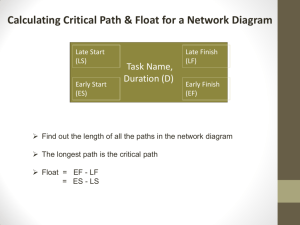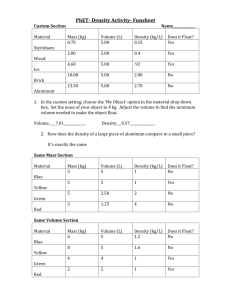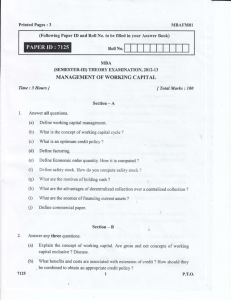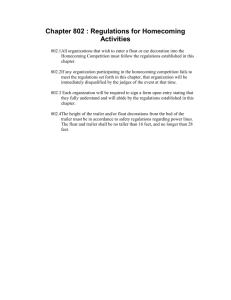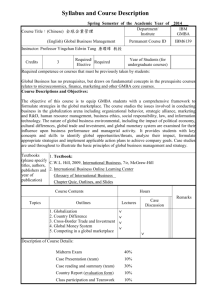civil - La Puerta Productions
advertisement
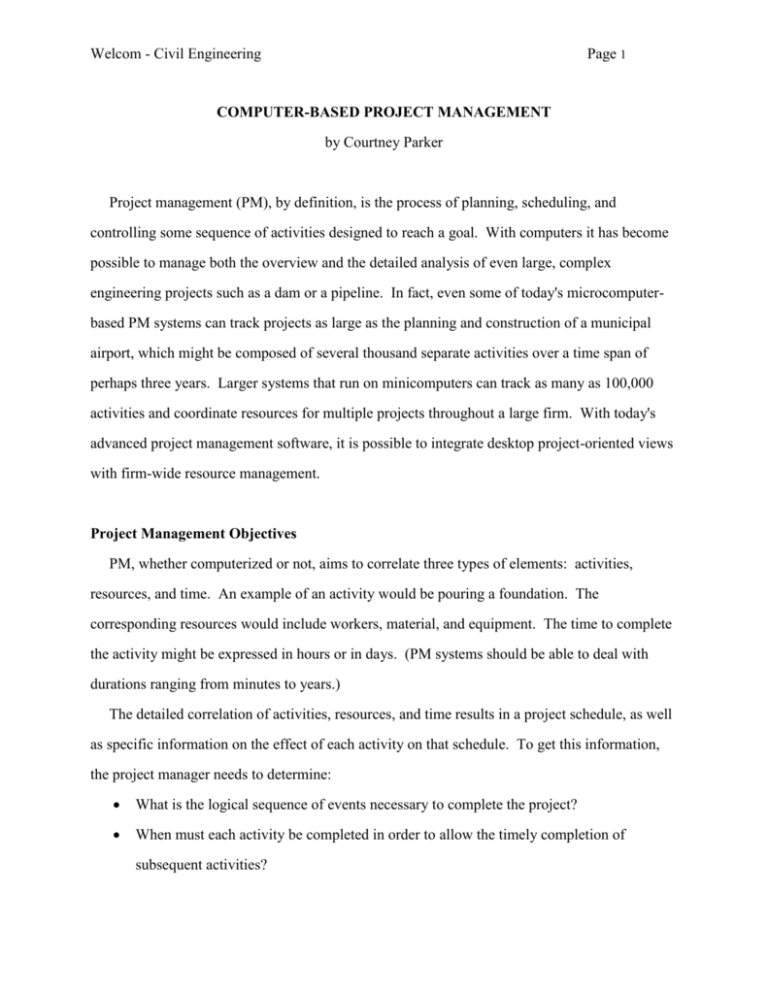
Welcom - Civil Engineering Page 1 COMPUTER-BASED PROJECT MANAGEMENT by Courtney Parker Project management (PM), by definition, is the process of planning, scheduling, and controlling some sequence of activities designed to reach a goal. With computers it has become possible to manage both the overview and the detailed analysis of even large, complex engineering projects such as a dam or a pipeline. In fact, even some of today's microcomputerbased PM systems can track projects as large as the planning and construction of a municipal airport, which might be composed of several thousand separate activities over a time span of perhaps three years. Larger systems that run on minicomputers can track as many as 100,000 activities and coordinate resources for multiple projects throughout a large firm. With today's advanced project management software, it is possible to integrate desktop project-oriented views with firm-wide resource management. Project Management Objectives PM, whether computerized or not, aims to correlate three types of elements: activities, resources, and time. An example of an activity would be pouring a foundation. The corresponding resources would include workers, material, and equipment. The time to complete the activity might be expressed in hours or in days. (PM systems should be able to deal with durations ranging from minutes to years.) The detailed correlation of activities, resources, and time results in a project schedule, as well as specific information on the effect of each activity on that schedule. To get this information, the project manager needs to determine: What is the logical sequence of events necessary to complete the project? When must each activity be completed in order to allow the timely completion of subsequent activities? Welcom - Civil Engineering Page 2 With this information, the project manager has an overview and a specific forecast on project completion, as well as the means to assess the impacts of any change -- in project design, external circumstances, or resource availability. Project Logic - Alternative Approaches To help project managers visualize these interrelationships, various kinds of logic diagrams have been developed. The two methods in common use are the arrow diagramming method (ADM) shown in Figure 1 and the precedence diagramming method (PDM) shown in Figure 2. Any computer-based PM system is, in effect, an electronic model of these logical relationships. Ideally, a PM system should support both of these methods. In ADM, activities are shown as arcs, or arrows, among events, or nodes. Another term for ADM is activity-on-arrow. Each activity has a beginning node (called the I-node) and an ending node (called the J-node). Some project managers prefer ADM representation because logical relationships can be determined simply by defining a beginning and an ending node for each activity. PDM diagrams represent activities as nodes and the relationships among them as arcs. As compared with ADM, PDM requires more precise definition of relationships. The relationship between an activity and its preceding or succeeding activities must be specified as one of the following types: Finish-to-start (FS) -- The activity must be completed before the other activity can begin. For example, a foundation must be poured before a structure can be erected upon it. Finish-to-finish (FF) -- The activity must be completed before the other activity can be completed. Wiring must be completed before the circuit can be tested. Start-to-start (SS) -- The activity must begin before the other activity can begin. Welcom - Civil Engineering Page 3 Reinforcing rods must be set before concrete can be poured. Start-to-finish (SF) -- The activity must begin before the other activity can be completed. Wire must be pulled before components can be connected. Along with beginning and ending dates, the type of relationship determines the effect of a delay in an activity. Calculating Project Dates Based on the inputs just described, a computer-based PM system can develop project schedules by calculating beginning and ending dates for each activity. A related calculation -essential to efficient project management -- is activity float, or the duration (usually in days) by which an activity can be delayed without affecting any other activities. In a PM system such as OPEN PLAN, a project is created by defining its activities and their logical relationships to other activities, and specifying the duration of each activity. From this data, the system performs time analysis, which calculates the following set of dates for each activity: Early start -- Based on the durations of preceding activities, this is the earliest date the activity can begin. Late start -- Based on the duration and the durations of succeeding activities, this is the latest projected start date for the activity. Early finish -- Based on the duration and the durations of preceding activities, this is the first possible completion date for the activity. Late finish -- Based on the duration and the durations of succeeding activities, this is the latest date an activity can be completed. Welcom - Civil Engineering Page 4 In turn, the float of an activity is derived from these date calculations. The correlation of duration and float to the dates is shown in the time line in Figure 3. Float can be calculated in either of two ways, depending upon what the project manager wants to know: Free float -- This is the amount of delay that can occur without a delay in subsequent activities. Free float is helpful in building flexibility into the project schedule. Total float -- This is the amount of delay that can be tolerated without affecting the project completion date. The total float of an activity determines whether its performance is critical to project completion. Float can also be either positive or negative. Positive float occurs when the duration of an activity is shorter than the time available for it, permitting some slippage. Float is zero or negative if there is a specific deadline for the activity and no slippage can be tolerated. A key determination is the critical path for the project, as shown in Figure 4. A common misconception is that the critical path is the shortest path through a network of activities. However, the critical path is actually the longest path, which is the minimum project duration. In other words, there is no way to shortcut the critical path, and the project completion date depends on the sequence of activities that lie along it. A delay in any of these activities will affect the project deadline. PM software calculates the critical path from activity float: Any activity that has a total float of zero or less must lie along the critical path. Determining the activity float and the critical path helps the project manager set priorities so that, at minimum, the absolutely essential activities get the resources they need. Welcom - Civil Engineering Page 5 Resource Management Among the most powerful features of computer-based PM systems is the ability to perform resource leveling, or allocation of resources for best efficiency among ongoing activities, and even among concurrent projects. In technical terms, resource leveling involves relaxing the rules of resource scheduling in specific ways. For any activity, these ways can include: Splitting Stretching Re-profiling. Splitting an activity causes it to be scheduled as two or more separate segments. Splitting starts the activity sooner than would otherwise be possible to work around gaps in the availability of a required resource. For example, if an activity required three workers for four days, it might be scheduled as two segments of two days each if the three workers were not available for any consecutive four-day period. In practical terms, splitting permits resources to be shared or loaned among ongoing activities. Stretching lengthens the duration of an activity so as to reduce the peak requirement for a key resource. For example, assume that an activity requires six workers per day for two days, but there are only three workers available. It may be possible to lengthen the duration to four days to meet the requirement of 12 worker-days. Re-profiling can involve both splitting and stretching so that the total resource requirement for an activity is met in spite of availability shortages on specific days. Re-profiling permits resources to be used as they become available rather than all at once. From the standpoint of the project Welcom - Civil Engineering Page 6 manager faced with resource shortages, re-profiling an activity can be a way of "playing catchup." Re-profiling, in particular, is a complex calculation that formerly was available only on largescale PM systems. However, all three of these techniques, including re-profiling, are available with PC and Macintosh versions of OPEN PLAN, which also runs on the VAX, a large-scale multiuser machine. The desktop versions of OPEN PLAN are sufficiently powerful for a major project to be managed with a single microcomputer. There is still a significant role for large-scale systems such as the VAX, not only for very big projects but also for resource management across multiple projects firm-wide. Such corporate-level project management becomes possible if the PM system can be run on both small- and large-scale computers, or on different platforms. OPEN PLAN, for example, provides compatibility of data files across multiple platforms, permitting project-level data to be maintained on individual workstations, which, in turn, can be linked within a corporate network. PM Software PM software for desktop microcomputers has kept pace with rapid increases in hardware performance and capacity, which now include 32-bit microprocessors such as the Intel 80386 and 80486 (available in PC-type machines) and the Motorola 68000 series (Macintosh). The result is that even moderately large projects can be handled readily by a single microcomputer. Performance on computation-intensive time analysis is a particularly good indication of the power of these desktop systems. For example, OPEN PLAN/Mac running on a Macintosh II can perform a time analysis on a large project containing about 10,000 activities in approximately two minutes. PM software design has benefited from the trend toward menu-driven screens and extensive use of the mouse for making selections. A sample of an OPEN PLAN/Mac input screen is Welcom - Civil Engineering Page 7 shown in Figure 4. Advantages of this approach relate primarily to ease of use. So, user training can concentrate on the principles of project management rather than on the technical aspects of computer operation. Another important trend in PM software is toward relational database systems. With a relational database, users need not be limited to rigid or predefined data structures. Input screens and reporting formats can be changed in a wide variety of ways to suit the requirements of specific projects and applications. For example, OPEN PLAN is designed around the Foxbase+ relational database package. In OPEN PLAN, activity records are set up initially with two code fields by which data may be searched, sorted, and reported. However, due to the flexible data structure of Foxbase, additional code fields may be added to permit resource tracking and reporting by a wider variety of criteria. The Welcom Reporting Language, which is built around Foxbase, permits users to design their own report formats without having technical knowledge about database programming. The relational Foxbase database management capability also makes possible the firm-wide PM discussed previously. The Mac version of OPEN PLAN is data binary compatible with the PC version, allowing access between these platforms without any data conversion. Firm-wide PM Integration An integrated network for firm-wide PM is shown in Figure 5. From a technical standpoint, individual project managers are free to select either PC or Mac versions of the OPEN PLAN system with the confidence that data can be exchanged easily, if necessary. Ordinarily, each workstation would be dedicated to a single project or project segment, although there is no software limitation on the number of projects per system. On Mac systems, each project network may contain up to 10,000 activities. As pointed out previously, an automatic conversion step is involved in moving data to the VAX host, which also uses the Foxbase+ relational database. Data on projects may be collected Welcom - Civil Engineering Page 8 by the host for resource leveling -- including activity splitting, stretching, or re-profiling -among multiple concurrent projects. With this type of integration, a firm can make the most efficient use of internal resources, as well as take advantage of the most favorable terms on subcontracts. Given the pressures of today's marketplace, this enhanced efficiency could mean significant improvement in a firm's overall cost effectiveness and competitive position. Summary With the introduction of OPEN PLAN/Mac, project managers have a choice between PC and Mac versions of an integrated PM system, with fully interchangeable data files. Due to the power of 32-bit microcomputers, either desktop version is sufficiently powerful to handle major engineering and construction projects. Furthermore, compatibility with the Foxbase+ relational database and VAX hardware provide the potential for integrating project management on a firmwide basis for corporate-level management of multiple projects. ### Welcom - Civil Engineering Page 9 Suggested List of Illustrations Figure 1. ADM and PDM project logic diagrams Figure 2. Time line showing early/late start/finish dates, as well as duration and float Figure 3. PDM diagram with critical path highlighted Figure 4. Input screen example (OPEN PLAN/Mac) Figure 5. Network diagram, large-scale PM system with VAX host and PC and/or Mac workstations ###



